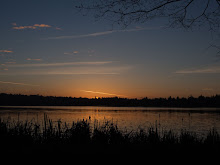Maybe if I had lived in Arizona, the geology class would have had a different impact on me. I had read articles by creationists who told of observing the layers exposed in Grand Canyon. And some layers were missing. The evidence was right there in your face. The standard geological story did not seem plausible. How could you reconcile a million years between two apparently smoothly adjoining layers? So maybe, if I had taken geology at Flagstaff Community College it would have been different. But I didn't live in Arizona.
When I signed up for Geology 101 at Suffolk County Community College, I had my guard up. I knew the professor would teach stuff I didn't believe. He would talk about about millions of years and evolution and horse fossils. But, I figured, it was time to face it. I had read everything the church had published on earth history. Intellectual integrity obliged me to find out what the other side had to say. And not from secondary sources. Besides, quite apart from the evolution/creation controversies rocks had fascinated me all my life.
Tom showed up in classic science professor attire, jeans and sweatshirt. He was only a couple of years older than I was. Everyone else in class was under twenty. They wore standard student uniforms–blue jeans and sweat shirts at beginning of the term in January, shorts and T-shirts come May. I wore my ministerial uniform–wool tweed jacket, dress slacks and knitted wool tie.
In the first few weeks of class we learned basic geological jargon, the major periods of geologic column–Cambrian, Permian, Jurassic, Pleistocene, etc.–with their putative dates, states of matter. It was elementary, pedestrian stuff, but since it was geology, I loved it. In lab we broke rocks with hammers, analyzed them with chemicals, stared at them through magnifying lenses. There was not a lot of room for evolutionary “opinions” or bias or prejudice. We were dealing with down-to-earth, concrete stuff.
I kept waiting for the teacher to get around to evolution.
We took field trips. We visited the central ridge of the island. Boulders and sand. On south shore beaches we observed erosion patterns created by winter storms. We visited construction sites where precautions against cave-ins had to be taken during any excavation. We checked out areas where we could smell the septic system seapage polluting creeks.
Geology, as Tom taught it, was not about theoretical links between dinosaurs and birds or the resetting of radiometric clocks during volcanic eruptions. Geology was primarily about providing essential knowledge for present living. Geology offered crucial information with a direct bearing on managing gasoline tanks, siting land fills, handling sewage, placing wells, and doing construction. For a bunch of godless scientists, geologists appeared to be unusually concerned about the health and well-being of society.
We couldn't completely escape history. The very land we lived on begged for an explanation. Why was the soil in my backyard so utterly different from any soil I had ever encountered before? When I dug my garden why did I encounter rocks of all different sizes and compositions? Why were the forests of eastern and southern Long Island so anemic? There was plenty of rain. Why didn't the trees grow? Why were there rocks in my yard and none in the yard of the Babylon Church? Why were there endless beaches all along the Atlantic shore?
The only plausible explanation for Long Island was glaciers. Huge glaciers. Glaciers a thousand feet thick that covered the entire states of Massachusetts and Connecticut. Ironically, the conference office was located on Shelter Rock Road a few hundred yards from the eponymous Shelter Rock, an 1800-ton glacial erratic. The mineral composition of this forty feet long, twenty feet wide, fifteen feet high rock matched bedrock in Connecticut, a hundred miles north across Long Island Sound. The only plausible method of transport for Shelter Rock and other large boulders imbedded in the sand and gravels of Long Island was the movement of massive ice sheets across New England.
The position, shape and composition of Long Island made perfect sense if you accepted continental glaciers. Long Island made no sense at all if you tried to explain it using Noah’s flood. The visible, obvious features of my everyday world shouted about an element of earth history—continental glaciers, an ice age—that was not even hinted at in the Bible, and, in fact, could not be fit into most creationist narratives.
One chapter in our book did offer a bit of hope for creationist theories. When plate tectonics was first proposed, the leading professors, the papa bears of the geological establishment, vociferously opposed it, ridiculed it. When these men died off, they were replaced by their graduate students who embraced this new understanding of earth history. As a creationist, I could hope that perhaps some day there would be a similar upheaval in the conventional understanding of geochronology.
We never did get around to spending much time talking about evolution. Geology 101 did not challenge my creationist beliefs by presenting evolutionary theories. What it did do was erode my confident dismissal of geology as a hopelessly bias-dominated philosophy. I experienced geology as a science, as a system of knowledge-seeking firmly rooted the the real world. The geological theory about Long Island readily lined up with evidence that was available to me through direct observation. I didn't need a microscope or sophisticated machinery for measuring radio isotopes. I wasn't dependent on diagrams in books. The evidence was large, visible and ubiquitous. Then, perhaps most importantly, the geological theory about our island offered concrete guidance for public policy and wise living.
Geologists might be wrong on this or that particular point, but their connection with the real world and their versions of truth were at least as credible as the science of creationists.
Friday, March 18, 2011
Subscribe to:
Comments (Atom)

